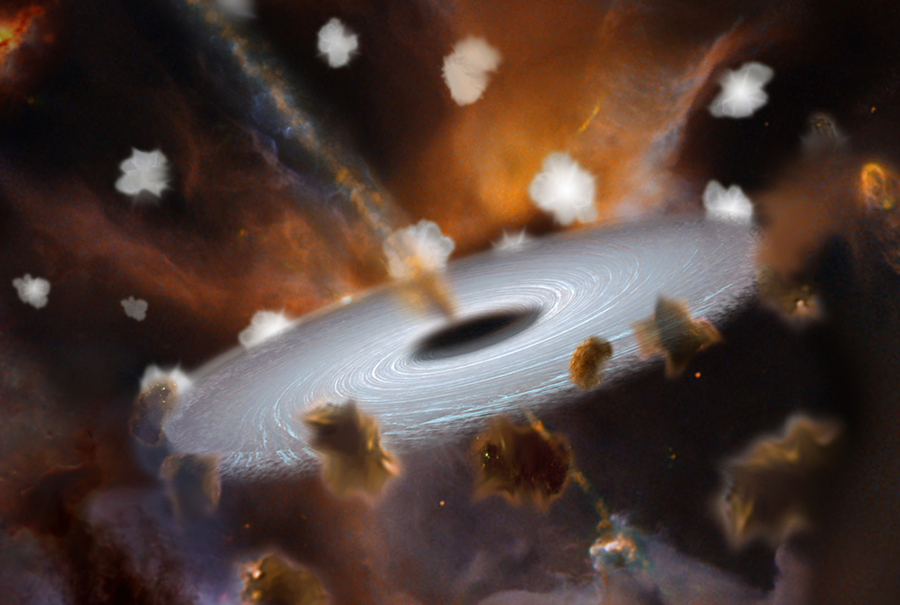Oct 1 2020
Recently, a glimpse of the processes occurring in the centers of “active galaxies” was provided by a group of astronomers from UC San Diego’s Center for Astrophysics and Space Sciences (CASS), NASA Goddard Space Flight Center (GSFC), the University of Maryland, and Leibniz Institute for Astrophysics Potsdam in their study published in The Astrophysical Journal.
 Artist’s illustration of gas and dust as it swirls toward the supermassive black hole—some matter forms a flat “accretion disk” that feeds the black hole directly, while other matter forms numerous compact clouds that can orbit the black hole farther out. Image Credit: Jay Friedlander (NASA/GSFC) and Sibasish Laha (NASA/GSFC), et. al (2020).
Artist’s illustration of gas and dust as it swirls toward the supermassive black hole—some matter forms a flat “accretion disk” that feeds the black hole directly, while other matter forms numerous compact clouds that can orbit the black hole farther out. Image Credit: Jay Friedlander (NASA/GSFC) and Sibasish Laha (NASA/GSFC), et. al (2020).
Virtually every galaxy has a massive black hole at its core, and some are ravenous eaters that gobble up neighboring dust and gas. As a result, all these moving materials heat up and discharge a huge quantity of light from the accretion disk— the fuzzy halo of flowing gas and dust surrounding a black hole. Such systems are known as active galactic nuclei (AGN).
The areas close to these central black holes seem to be very small and far away that they are not visible directly. Therefore, astronomers like Alex Markowitz (CASS) and former UC San Diego postdoctoral scholars Sibasish Laha (assistant research scientist with NASA/GSFC and the University of Maryland), and Mirko Krumpe (Leibniz Institute for Astrophysics Potsdam) search for signatures in their light as a means to comprehend the kind of matter that is present.
By probing how the signatures alter over time, researchers can trace gas as it travels across the line of sight, and thus learn where various structures are close to the black hole.
With the help of European Space Agency’s XMM-Newton, NASA’s Chandra, and JAXA’s Suzaku telescopes, the team discovered three separate regions where the X-rays get absorbed by matter—that is, (1) compact clumpy clouds proximal to the black hole that move across the line of sight, (2) variable-density diffuse streams of matter that also move across the line of sight, and (3) dust lanes in the host galaxy.
Half of the sources show partial covering absorbers along the line of sight, implying very high-density gas sitting right next to the black hole.
Sibasish Laha, Study First Author and Assistant Research Scientist, NASA/GSFC and University of Maryland
Markowitz described that earlier papers (including his and Krumpe’s 2014 publication in the Monthly Notices of the Royal Astronomical Society) established that dusty and gaseous structures near accreting black holes can be present in numerous forms, such as discrete clouds—contrary to a smooth-density distribution theorized before.
“However, we wanted to map out these structures in more detail by studying a sample of the most-absorbed accreting black holes,” stated the CASS research scientist and affiliate of the Nicolaus Copernicus Astronomical Center, Polish Academy of Sciences. “The (new) study reveals a diverse range of types and locations of clouds across various AGNs and their host galaxies.”
The research also established that dust and gas in the host galaxy itself have an important role to play in how researchers explore these AGN systems. “Our ability to measure the properties of gas and dust near the black hole has to be disentangled from the role of the host galaxy’s gas and dust at large distance scales,” Markowitz observed.
According to Laha, the implication of this finding is how it helps researchers better comprehend the way matter around the neighborhood of the supermassive black hole is distributed, which is otherwise not visible to existing generation telescopes because of the lack of spatial resolution.
This matter, in the form of high-density clumps and continuous media, is responsible for feeding the ‘monster’ black hole and thereby keeping the AGN ‘active’ and bright.
Sibasish Laha, Study First Author and Assistant Research Scientist, NASA/GSFC and University of Maryland
According to Laha, the most unexpected outcome of the research was the discovery that not all AGN exhibit signatures of moving clouds along the line of sight on timescales of days–years, indicating that the clouds may be continuous or distant, and hence no inconsistency. This implies that the feeding nature of the massive black holes is not the same across different AGN.
As for their approach, Markowitz added that compared to the X-ray telescope, which was utilized in the 2014 research, the three X-ray telescopes in the 2020 research are more responsive to smaller differences in density, enabling the team to spot smaller-density clouds.
X-ray emission comes from some of the most energetic events very near the black holes and hence X-rays are the best probes of the ‘situation’ near the black hole. The accretion disk and the ‘corona’ emit in UV and X-rays, respectively, which comes to us directly.
Sibasish Laha, Study First Author and Assistant Research Scientist, NASA/GSFC and University of Maryland
“If there are clouds in the line of sight, then we see ‘dips’ in the incoming X-rays. These dips are measured carefully in the ‘spectra’ and then we investigate if these dips vary with time. If it varies with time, it means it’s moving across our line of sight. The variability timescale tells us the location of the clouds as they orbit the black hole,” Laha conclude.
The study was funded by NASA, through NASA-ADAP (award no. NNX15AE64G); and partial funding came from Narodowy Centrum Nauki (NCN), (grant no. 2016/23/B/ST9/03123) and DLR (grant nos. 50OR1802 and 50OR1904).
Journal Reference:
Laha, S., et al. (2020) The Variable and Non-variable X-Ray Absorbers in Compton-thin Type II Active Galactic Nuclei. The Astrophysical Journal. doi.org/10.3847/1538-4357/ab92ab.